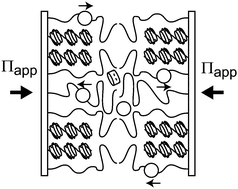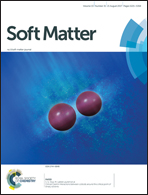Transcription dynamics stabilizes nucleus-like layer structure in chromatin brush†
Abstract
We use a brush of DNA in a solution of transcriptional machinery and histone proteins to theoretically predict that this brush shows phase separation due to the instability arising from the disassembly of nucleosomes during transcription. In the two-phase coexistent state, collapsed chains (with relatively large nucleosome occupancy) lie at the grafting surface and swollen chains (with relatively small nucleosome occupancy) are distributed at the space above the collapsed chains, analogous to the structure of chromatin in differentiated cells. This layer structure is stabilized by the lateral osmotic pressure of swollen chains. For a relatively small grafting density, DNA brushes show tricritical points because the entropic elasticity with respect to the lateral excursion of swollen chains balances with the lateral osmotic pressure of these chains. At the tricritical points, DNA brushes show large fluctuations of local nucleosome concentration, which may be reminiscent of the fluctuations observed in embryonic stem cells.



 Please wait while we load your content...
Please wait while we load your content...